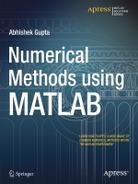Introduction
I had my first experience with MATLAB in my second year of engineering while working on control systems design. Later on, in my internship, I got an opportunity to develop a package named MAD in MATLAB under Dr Shaun A Forth at DCMT, UK. From there on, my interest in MATLAB kept on increasing. The journey thus started never stopped and MATLAB has become an inseparable component of my research life. I have become a big fan of MATLAB due to its simplicity and its vectorization capability. I enjoy programming in MATLAB. This book is my attempt to make others a fan of it too.
This book presents a wide range of numerical methods and their implementation in MATLAB with the help of examples to make the learning more interactive. A conventional method to teach numerical methods is to first give a detailed discussion of such methods and then present a few examples. This method is very far from being efficient and by the time the actual implementation comes, the user who is mainly interested in solving his own problems has already given up. This book takes a very different approach by stressing the concept of trying out techniques by oneself, and attempts to start the discussion with examples long before the actual theory is introduced. The idea behind the book came to me when I taught a course on MATLAB to a small batch of students at my home institution. During the course, I had encountered the problems which students face while learning it. As a student and researcher I understand what a researcher or student looks for in a book and hence I believe this book will proveto be valuable to the intended audience. Instead of bombarding users with theory and information, the book only gives concise and practical information to help you to effectively solve your research problem in less time.
This book presents each and every topic in a very concise and readable format which helps you to learn quickly and effectively. This book can also serve as a complementary book for a MATLAB course in engineering colleges. Also, it is designed to be a companion in your research anywhere you go. This book assumes that the user has a basic knowledge of MATLAB programming and quickly covers the MATLAB basics in the first chapter. If the user is not familiar with MATLAB, he should read some basic MATLAB books prior to starting this book. One such book is written by me and titled “MATLAB by Examples”, published by Finch Publications (2010).
This book is divided into 10 chapters. The first two chapters are written to help users to quickly understand MATLAB. Chapter 1 covers the basic programming paradigm of MATLAB, including how to write functions, scripts and data structures. Lecture 2 quickly covers one of the most important features of MATLAB known as vectorization, which will help you to write efficient programs in MATLAB.
The third chapter is probably the most important chapter and provides the foundation of the book. It covers all the important operations basic to any numerical computation. Once the user is familiar with these fundamental operations and learns how to implement them, the rest of the book should come naturally to him.
The fourth chapter provides a quick tutorial for visualizing any output and results in MATLAB using simple plots and animations.
The fifth chapter discusses the primary concepts and methodology behind any numerical simulation. It talks about how we can solve any numerical computations using MATLAB and presents some key examples to elaborate the topics more clearly. Building on the fifth chapter, the sixth chapter incorporates random components in any system or simulation and introduces the idea behind Monte Carlo simulations.
Chapter 7 acquaints you with the powerful tool of optimization in MATLAB. Since MATLAB provides a wide range of inbuilt functions to solve any optimization problem, this chapter gives a comprehensive review of all the important methods. However, learning to implement such methods from scratch is also crucial to developing a proper understanding and approach towards numerical methods. The chapter also elaborates the paradigm behind the full implementation of such methods with examples. Building on this, Chapter 8 presents a brief but complete description of evolutionary algorithms such as the genetic algorithm and swarm intelligence algorithms, e.g. particle swarm optimization.
Chapter 9 is written for data scientists and statisticians. Regression and model fitting play an important role in all modern era applications, be it time-series analysis or market prediction in the financial domain or the recommender system in online economics. This chapter covers the main approach behind regression with an appropriate amount of theory to provide an optimal reading and learning experience for the users.
Chapter 10 is written for control system engineers and researchers interested in understanding the dynamics of any system. It is built on Chapters 5 and 6 and, using tools from these two chapters and inbuilt functions, it provides a concise yet detailed overview of simulating the dynamics and time evolution of real world continuous and discrete systems.
